Improving Specific Absorption Rate Efficiency and Coil Robustness of Self-Decoupled Transmit/Receive Coils by Elevating Feed and Mode Conductors
Abstract
1. Introduction
2. Concept
3. Methods
3.1. Simulation
3.2. Coil Fabrication, Bench Test, and MRI Experiment
4. Results
4.1. Simulation Results
4.2. Bench Test and MRI Results
5. Discussion
6. Conclusions
Author Contributions
Funding
Institutional Review Board Statement
Informed Consent Statement
Data Availability Statement
Acknowledgments
Conflicts of Interest
References
- Lauterbur, P.C. Image formation by induced local interactions: Examples employing nuclear magnetic resonance. Nature 1973, 242, 190–191. [Google Scholar] [CrossRef]
- Vaughan, J.T.; Griffiths, J.R. RF Coils for MRI; John Wiley & Sons: Hoboken, NJ, USA, 2012. [Google Scholar]
- Roemer, P.B.; Edelstein, W.A.; Hayes, C.E.; Souza, S.P.; Mueller, O.M. The NMR phased array. Magn. Reson. Med. 1990, 16, 192–225. [Google Scholar] [CrossRef] [PubMed]
- Wright, S.M.; Wald, L.L. Theory and application of array coils in MR spectroscopy. NMR Biomed. 1997, 10, 394–410. [Google Scholar] [CrossRef]
- de Zwart, J.A.; Ledden, P.J.; Kellman, P.; van Gelderen, P.; Duyn, J.H. Design of a SENSE-optimized high-sensitivity MRI receive coil for brain imaging. Magn. Reson. Med. 2002, 47, 1218–1227. [Google Scholar] [CrossRef]
- Wiggins, G.C.; Triantafyllou, C.; Potthast, A.; Reykowski, A.; Nittka, M.; Wald, L. 32-channel 3 Tesla receive-only phased-array head coil with soccer-ball element geometry. Magn. Reson. Med. 2006, 56, 216–223. [Google Scholar] [CrossRef] [PubMed]
- Zhang, X.; Webb, A. Design of a four-coil surface array for in vivo magnetic resonance microscopy at 600 MHz. Concepts Magn. Reson. Part B Magn. Reson. Eng. Educ. J. 2005, 24, 6–14. [Google Scholar] [CrossRef]
- Keil, B.; Alagappan, V.; Mareyam, A.; McNab, J.A.; Fujimoto, K.; Tountcheva, V.; Triantafyllou, C.; Dilks, D.D.; Kanwisher, N.; Lin, W. Size-optimized 32-channel brain arrays for 3 T pediatric imaging. Magn. Reson. Med. 2011, 66, 1777–1787. [Google Scholar] [CrossRef]
- Zhu, Y.; Hardy, C.J.; Sodickson, D.K.; Giaquinto, R.O.; Dumoulin, C.L.; Kenwood, G.; Niendorf, T.; Lejay, H.; McKenzie, C.A.; Ohliger, M.A. Highly parallel volumetric imaging with a 32-element RF coil array. Magn. Reson. Med. 2004, 52, 869–877. [Google Scholar] [CrossRef]
- Schmitt, M.; Potthast, A.; Sosnovik, D.E.; Polimeni, J.R.; Wiggins, G.C.; Triantafyllou, C.; Wald, L.L. A 128-channel receive-only cardiac coil for highly accelerated cardiac MRI at 3 Tesla. Magn. Reson. Med. 2008, 59, 1431–1439. [Google Scholar] [CrossRef]
- Fujita, H.; Zheng, T.; Yang, X.; Finnerty, M.J.; Handa, S. RF surface receive array coils: The art of an LC circuit. J. Magn. Reson. Imaging 2013, 38, 12–25. [Google Scholar] [CrossRef]
- Adriany, G.; Van de Moortele, P.F.; Wiesinger, F.; Moeller, S.; Strupp, J.P.; Andersen, P.; Snyder, C.; Zhang, X.; Chen, W.; Pruessmann, K.P. Transmit and receive transmission line arrays for 7 Tesla parallel imaging. Magn. Reson. Med. 2005, 53, 434–445. [Google Scholar] [CrossRef]
- Alagappan, V.; Nistler, J.; Adalsteinsson, E.; Setsompop, K.; Fontius, U.; Zelinski, A.; Vester, M.; Wiggins, G.C.; Hebrank, F.; Renz, W. Degenerate mode band-pass birdcage coil for accelerated parallel excitation. Magn. Reson. Med. 2007, 57, 1148–1158. [Google Scholar] [CrossRef] [PubMed]
- Clément, J.D.; Gruetter, R.; Ipek, Ö. A human cerebral and cerebellar 8-channel transceive RF dipole coil array at 7T. Magn. Reson. Med. 2019, 81, 1447–1458. [Google Scholar] [CrossRef] [PubMed]
- Ertürk, M.A.; Raaijmakers, A.J.; Adriany, G.; Uğurbil, K.; Metzger, G.J. A 16-channel combined loop-dipole transceiver array for 7 T esla body MRI. Magn. Reson. Med. 2017, 77, 884–894. [Google Scholar] [CrossRef]
- Graessl, A.; Renz, W.; Hezel, F.; Dieringer, M.A.; Winter, L.; Oezerdem, C.; Rieger, J.; Kellman, P.; Santoro, D.; Lindel, T.D. Modular 32-channel transceiver coil array for cardiac MRI at 7.0 T. Magn. Reson. Med. 2014, 72, 276–290. [Google Scholar] [CrossRef]
- Jin, J.; Weber, E.; Destruel, A.; O’Brien, K.; Henin, B.; Engstrom, C.; Crozier, S. An open 8-channel parallel transmission coil for static and dynamic 7T MRI of the knee and ankle joints at multiple postures. Magn. Reson. Med. 2018, 79, 1804–1816. [Google Scholar] [CrossRef]
- Oezerdem, C.; Winter, L.; Graessl, A.; Paul, K.; Els, A.; Weinberger, O.; Rieger, J.; Kuehne, A.; Dieringer, M.; Hezel, F. 16-channel bow tie antenna transceiver array for cardiac MR at 7.0 tesla. Magn. Reson. Med. 2016, 75, 2553–2565. [Google Scholar] [CrossRef]
- Raaijmakers, A.; Ipek, O.; Klomp, D.; Possanzini, C.; Harvey, P.; Lagendijk, J.; Van den Berg, C. Design of a radiative surface coil array element at 7 T: The single-side adapted dipole antenna. Magn. Reson. Med. 2011, 66, 1488–1497. [Google Scholar] [CrossRef]
- Rietsch, S.H.; Orzada, S.; Bitz, A.K.; Gratz, M.; Ladd, M.E.; Quick, H.H. Parallel transmit capability of various RF transmit elements and arrays at 7T MRI. Magn. Reson. Med. 2018, 79, 1116–1126. [Google Scholar] [CrossRef] [PubMed]
- Sengupta, S.; Roebroeck, A.; Kemper, V.G.; Poser, B.A.; Zimmermann, J.; Goebel, R.; Adriany, G. A specialized multi-transmit head coil for high resolution fMRI of the human visual cortex at 7T. PLoS ONE 2016, 11, e0165418. [Google Scholar] [CrossRef]
- Shajan, G.; Kozlov, M.; Hoffmann, J.; Turner, R.; Scheffler, K.; Pohmann, R. A 16-channel dual-row transmit array in combination with a 31-element receive array for human brain imaging at 9.4 T. Magn. Reson. Med. 2014, 71, 870–879. [Google Scholar] [CrossRef] [PubMed]
- Wu, B.; Wang, C.; Kelley, D.A.; Xu, D.; Vigneron, D.B.; Nelson, S.J.; Zhang, X. Shielded microstrip array for 7T human MR imaging. IEEE Trans. Med. Imaging 2009, 29, 179–184. [Google Scholar] [PubMed]
- Yan, X.; Pedersen, J.O.; Wei, L.; Zhang, X.; Xue, R. Multichannel double-row transmission line array for human MR imaging at ultrahigh fields. IEEE Trans. Biomed. Eng. 2015, 62, 1652–1659. [Google Scholar] [CrossRef] [PubMed]
- Chen, H.; Guo, L.; Li, M.; Destruel, A.; Liu, C.; Weber, E.; Liu, F.; Crozier, S. Metamaterial-inspired radiofrequency (RF) shield with reduced specific absorption rate (SAR) and improved transmit efficiency for UHF MRI. IEEE Trans. Biomed. Eng. 2020, 68, 1178–1189. [Google Scholar] [CrossRef]
- Zhang, X.; Webb, A. Design of a capacitively decoupled transmit/receive NMR phased array for high field microscopy at 14.1 T. J. Magn. Reson. 2004, 170, 149–155. [Google Scholar] [CrossRef] [PubMed]
- Pinkerton, R.G.; Barberi, E.A.; Menon, R.S. Transceive surface coil array for magnetic resonance imaging of the human brain at 4 T. Magn. Reson. Med. 2005, 54, 499–503. [Google Scholar] [CrossRef]
- Li, Y.; Xie, Z.; Pang, Y.; Vigneron, D.; Zhang, X. ICE decoupling technique for RF coil array designs. Med. Phys. 2011, 38, 4086–4093. [Google Scholar] [CrossRef]
- Yan, X.; Zhang, X.; Feng, B.; Ma, C.; Wei, L.; Xue, R. 7T transmit/receive arrays using ICE decoupling for human head MR imaging. IEEE Trans. Med. Imaging 2014, 33, 1781–1787. [Google Scholar] [CrossRef]
- Yan, X.; Zhang, X.; Wei, L.; Xue, R. Magnetic wall decoupling method for monopole coil array in ultrahigh field MRI: A feasibility test. Quant. Imaging Med. Surg. 2014, 4, 79. [Google Scholar]
- Yan, X.; Wei, L.; Xue, R.; Zhang, X. Hybrid monopole/loop coil array for human head MR imaging at 7 T. Appl. Magn. Reson. 2015, 46, 541–550. [Google Scholar] [CrossRef]
- Yan, X.; Zhang, X.; Wei, L.; Xue, R. Design and test of magnetic wall decoupling for dipole transmit/receive array for MR imaging at the ultrahigh field of 7T. Appl. Magn. Reson. 2015, 46, 59–66. [Google Scholar] [CrossRef] [PubMed]
- Yan, X.; Gore, J.C.; Grissom, W.A. Self-decoupled radiofrequency coils for magnetic resonance imaging. Nat. Commun. 2018, 9, 1–12. [Google Scholar] [CrossRef] [PubMed]
- Hoult, D. The principle of reciprocity in signal strength calculations—A mathematical guide. Concepts Magn. Reson. 2000, 12, 173–187. [Google Scholar] [CrossRef]
- Metzger, G.J.; van de Moortele, P.F.; Akgun, C.; Snyder, C.J.; Moeller, S.; Strupp, J.; Andersen, P.; Shrivastava, D.; Vaughan, T.; Ugurbil, K. Performance of external and internal coil configurations for prostate investigations at 7 T. Magn. Reson. Med. 2010, 64, 1625–1639. [Google Scholar] [CrossRef]
- Homann, H.; Börnert, P.; Eggers, H.; Nehrke, K.; Dössel, O.; Graesslin, I. Toward individualized SAR models and in vivo validation. Magn. Reson. Med. 2011, 66, 1767–1776. [Google Scholar] [CrossRef] [PubMed]
- Ipek, Ö.; Raaijmakers, A.J.; Lagendijk, J.J.; Luijten, P.R.; van den Berg, C.A. Intersubject local SAR variation for 7T prostate MR imaging with an eight-channel single-side adapted dipole antenna array. Magn. Reson. Med. 2014, 71, 1559–1567. [Google Scholar] [CrossRef] [PubMed]
- Nehrke, K.; Börnert, P. DREAM—A novel approach for robust, ultrafast, multislice B1 mapping. Magn. Reson. Med. 2012, 68, 1517–1526. [Google Scholar] [CrossRef]
- Lakshmanan, K.; Cloos, M.; Brown, R.; Lattanzi, R.; Sodickson, D.K.; Wiggins, G.C. The “loopole” antenna: A hybrid coil combining loop and electric dipole properties for ultra-high-field MRI. Concepts Magn. Reson. Part B Magn. Reson. Eng. 2020, 2020, 8886543. [Google Scholar] [CrossRef]
- Zheng, M.; Gao, Y.; Quan, Z.; Zhang, X. The design and evaluation of single-channel loopole coils at 7T MRI. Phys. Med. Biol. 2022, 67, 195003. [Google Scholar] [CrossRef]

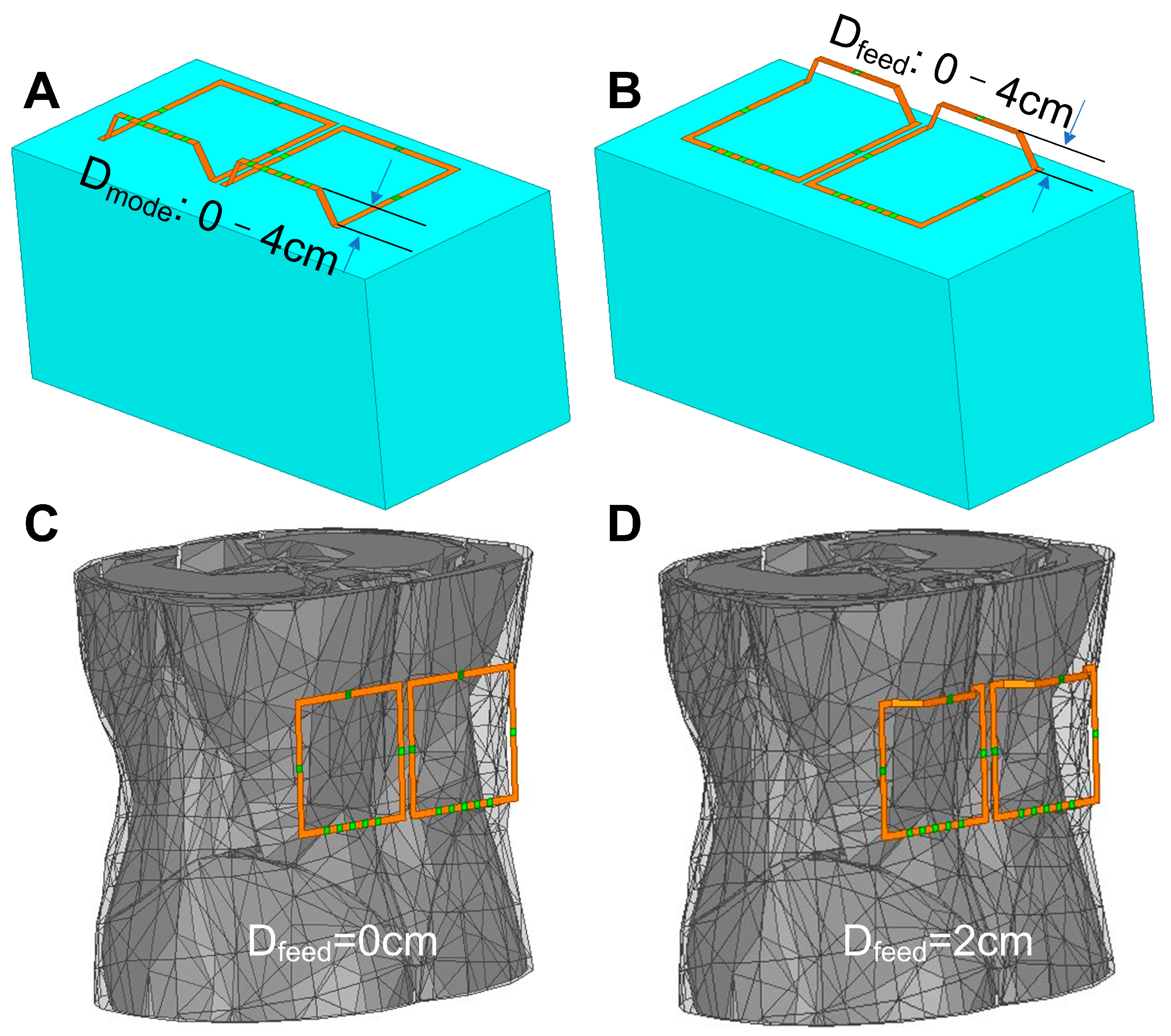
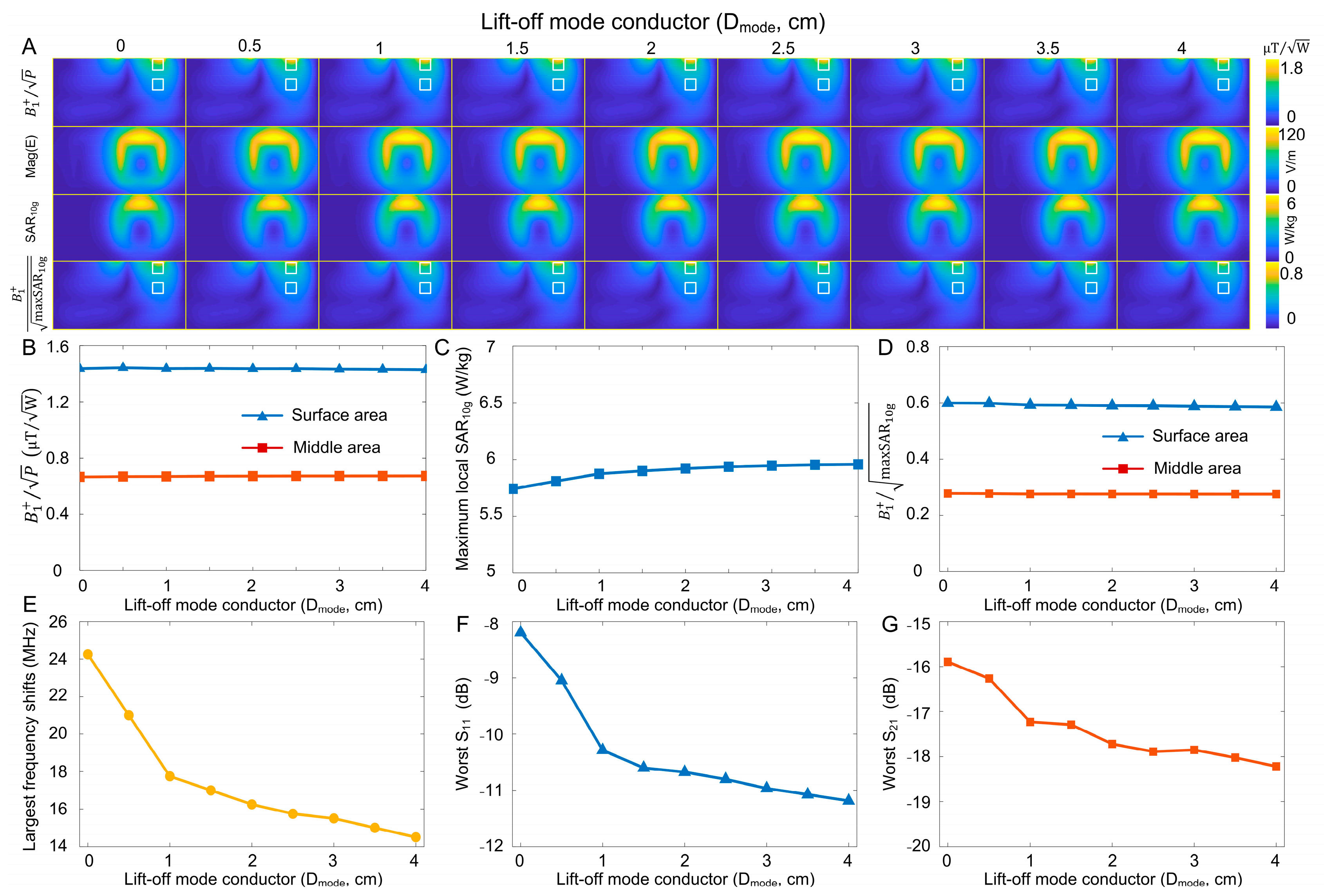
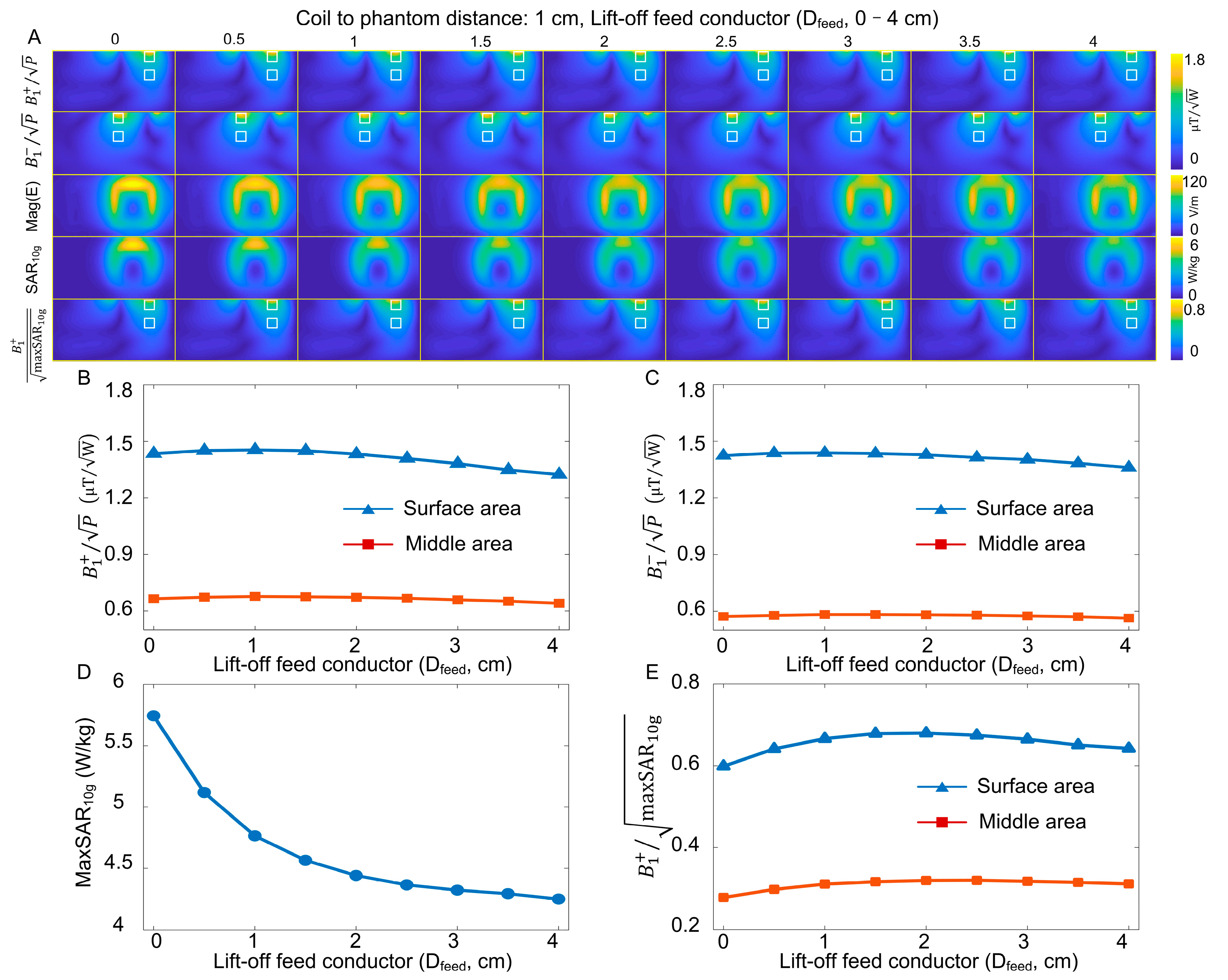


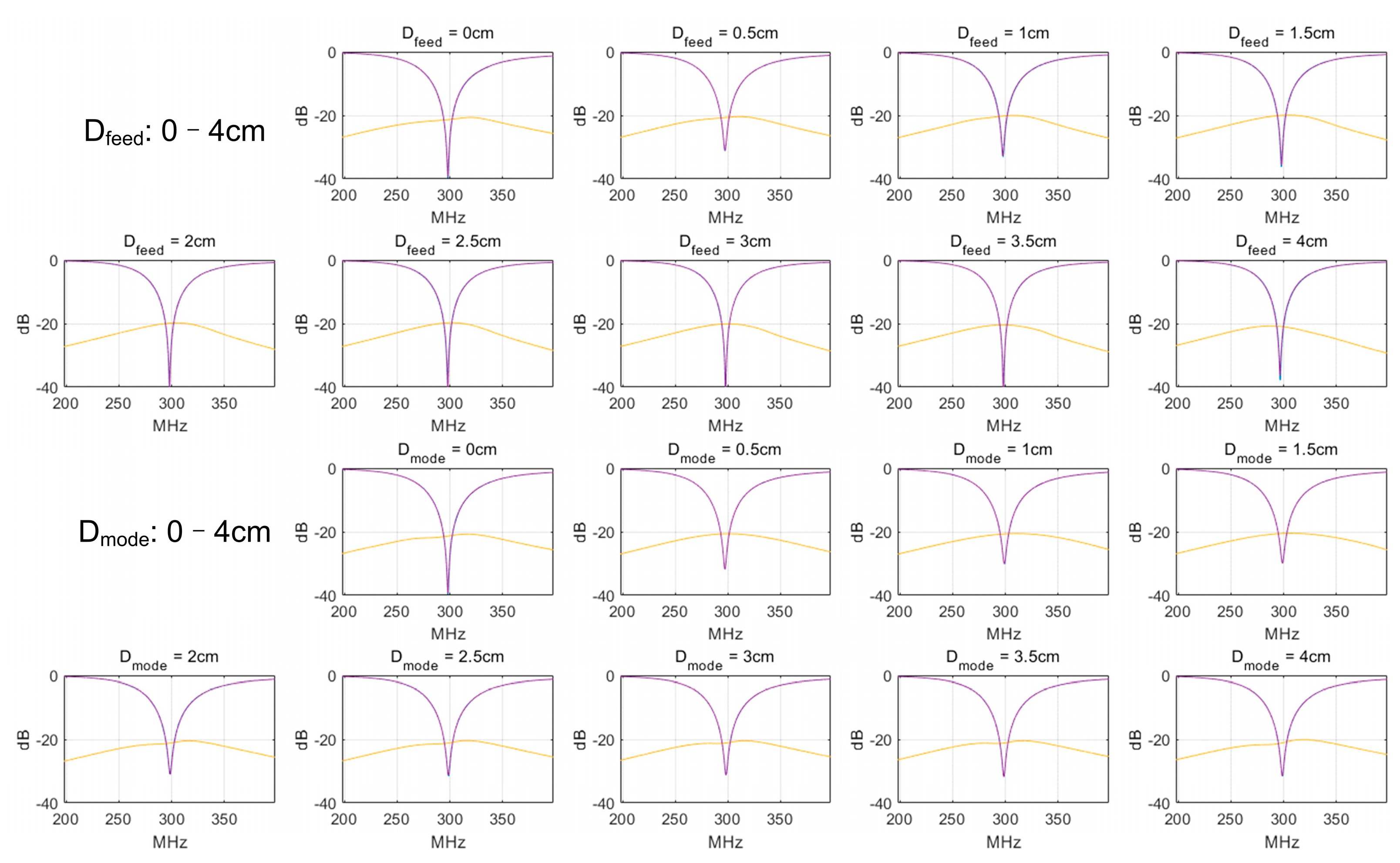
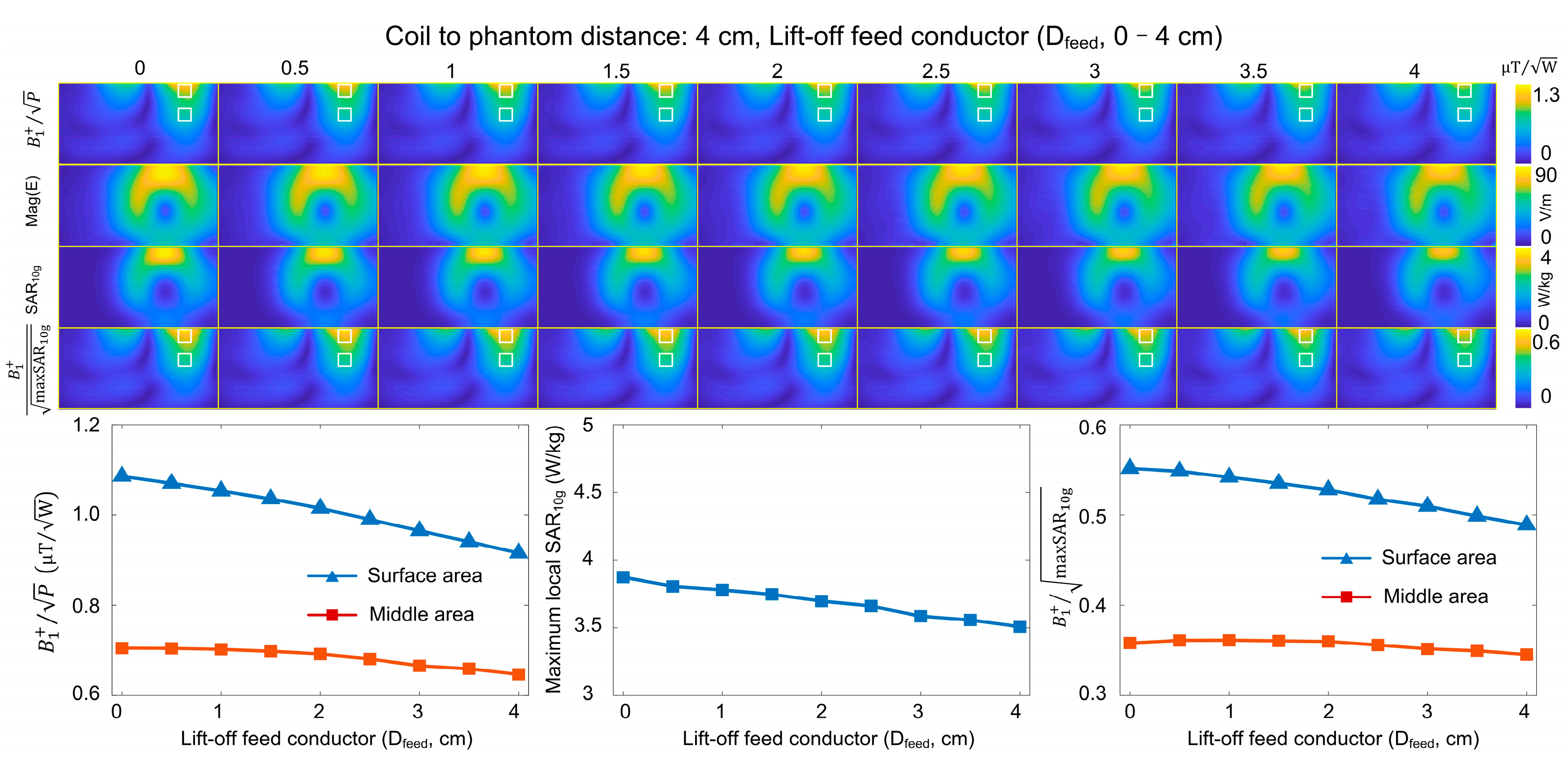

Disclaimer/Publisher’s Note: The statements, opinions and data contained in all publications are solely those of the individual author(s) and contributor(s) and not of MDPI and/or the editor(s). MDPI and/or the editor(s) disclaim responsibility for any injury to people or property resulting from any ideas, methods, instructions or products referred to in the content. |
© 2023 by the authors. Licensee MDPI, Basel, Switzerland. This article is an open access article distributed under the terms and conditions of the Creative Commons Attribution (CC BY) license (https://creativecommons.org/licenses/by/4.0/).
Share and Cite
Lu, M.; Zhang, X.; Chai, S.; Yan, X. Improving Specific Absorption Rate Efficiency and Coil Robustness of Self-Decoupled Transmit/Receive Coils by Elevating Feed and Mode Conductors. Sensors 2023, 23, 1800. https://doi.org/10.3390/s23041800
Lu M, Zhang X, Chai S, Yan X. Improving Specific Absorption Rate Efficiency and Coil Robustness of Self-Decoupled Transmit/Receive Coils by Elevating Feed and Mode Conductors. Sensors. 2023; 23(4):1800. https://doi.org/10.3390/s23041800
Chicago/Turabian StyleLu, Ming, Xiaoyang Zhang, Shuyang Chai, and Xinqiang Yan. 2023. "Improving Specific Absorption Rate Efficiency and Coil Robustness of Self-Decoupled Transmit/Receive Coils by Elevating Feed and Mode Conductors" Sensors 23, no. 4: 1800. https://doi.org/10.3390/s23041800
APA StyleLu, M., Zhang, X., Chai, S., & Yan, X. (2023). Improving Specific Absorption Rate Efficiency and Coil Robustness of Self-Decoupled Transmit/Receive Coils by Elevating Feed and Mode Conductors. Sensors, 23(4), 1800. https://doi.org/10.3390/s23041800





